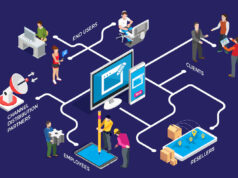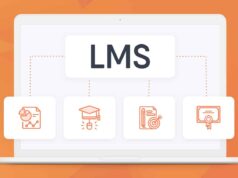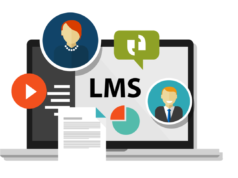
Nowadays, employers are always searching for tools and strategies to streamline operations, boost productivity, and cultivate a productive workforce. One tool that has become increasingly popular is the Learning Management System (LMS).
An LMS is a software application that enables organizations to create, manage, and deliver e-learning courses to their employees. If you’re considering integrating an LMS into your organization, here are twelve points you should know:
1. Cost Effective Training Solution

Traditional training methods can be expensive and time-consuming as they often involve travel expenses, venue rentals, and instructor fees. By utilizing an LMS for business, you can provide training without the need for infrastructure, leading to significant cost reductions.
Additionally, updating and reusing training materials becomes effortless with an LMS, ensuring your employees have access to up-to-date information without incurring costs.
2. Enhanced Accessibility and Flexibility
Unlike classroom training, an LMS offers employees the flexibility to access training materials at any time and from anywhere. Whether your employees work remotely, on-site, or even across time zones, they can conveniently access courses when it suits them best.
This flexibility results in employee engagement and a greater completion rate for training programs.
3. Improved Learning Experience
Learning management systems (LMS) offer features that can enhance the overall learning experience. These features include quizzes, assessments, discussion forums, and multimedia content, all of which contribute to effective training.
By incorporating gamification elements like badges and leaderboards, you can also motivate employees to participate and achieve fruitful outcomes.
4. Customizable to Meet Your Organization’s Needs

One of the advantages of an LMS is its flexibility and ability to be customized. You have the freedom to tailor the platform according to your organization’s requirements and objectives.
This includes customizing the appearance of the platform, incorporating your elements, and personalizing the content to reflect your organization’s culture and values. This level of customization ensures that employees receive training that’s relevant and tailored to their roles and responsibilities.
5. Convenient Tracking and Reporting
With an LMS in place, tracking employee progress and performance becomes effortless. Through built-in reporting features, you can easily monitor an individual’s progress, identify areas where additional knowledge may be needed, and evaluate the effectiveness of your training programs. These insights driven by data empower you with the ability to make decisions and continually enhance your training initiatives.
6. Smooth Integration with Existing Systems
Integrating a Learning Management System (LMS) with your HR or talent management systems is crucial for ensuring a seamless learning experience. Your LMS should be capable of integrating with your organization’s Single Sign-On (SSO) system, employee directory, and performance management system.
This integration enables user management and streamlines administrative processes. It is essential to choose an LMS that can integrate smoothly with your existing systems to avoid duplicating efforts and maintaining sets of data.
7. Strong Security Features
When it comes to managing employee data and sensitive information, security becomes paramount. An LMS ensures the storage and transmission of data through security measures such as data encryption, user authentication, and role-based access controls. Moreover, an LMS should comply with industry standards and regulations concerning data protection in order to create a learning environment for your employees.
8. Scalability to Support Growth

As your organization expands, so does your workforce. With an LMS in place, you can easily scale up your training programs to accommodate employees. Whether you’re bringing team members on board, training existing staff in skills, or refreshing their knowledge, an LMS can handle the increased demand without compromising the quality of the training. This flexibility ensures that your training efforts can keep up with your business growth.
9. Ongoing Development
Continuous learning and development are vital for both employees and organizations to succeed. An LMS allows you to provide training and development opportunities for your employees, ensuring they stay updated with industry trends and best practices. By investing in their growth, you can enhance their motivation, engagement, and loyalty to your organization.
10. Enhanced Employee Performance and Retention
Implementing an LMS can lead to employee performance and higher rates of retention. By equipping employees with the training and resources to excel in their roles, you empower them to perform at their best.
This boosts productivity and fosters job satisfaction and loyalty. Additionally, providing learning opportunities through an LMS creates a work environment that helps attract and retain top talent. Furthermore, an LMS facilitates personalized learning paths, allowing employees to acquire new skills and knowledge tailored to their specific roles and career goals.
11. Mobile Learning Compatibility

In the contemporary landscape dominated by mobile devices, the imperative for an LMS to support mobile learning cannot be overstated. A forward-thinking LMS should seamlessly extend its functionalities to mobile platforms. This means ensuring your chosen LMS platform is not merely compatible but genuinely mobile-friendly.
The significance lies in empowering employees to access training materials effortlessly on their smartphones and tablets. This not only accommodates the modern workforce’s on-the-go nature but also caters to remote employees. This enhances the overall accessibility of the learning experience and fosters a culture of continuous learning irrespective of physical location.
12. Collaborative Learning Features
Beyond content delivery, an LMS should serve as a catalyst for fostering a collaborative learning environment within your organization. Opting for an LMS equipped with collaborative features is pivotal. Discussion forums, group projects, and interactive sessions are integral components that promote knowledge-sharing and community-building among employees.
By facilitating collaborative learning, an LMS transforms the training environment into a dynamic space where employees can learn from the content and each other too. This further encourages teamwork and creates a sense of camaraderie within the workforce.
Conclusion
An LMS has the potential to transform your organization’s training and development initiatives. Through the utilization of technology, a Learning Management System (LMS) empowers you to provide your employees with cost-adaptable and compelling training opportunities.
With its attributes, strong security measures, and seamless integration capabilities, an LMS serves as an asset that can boost employee performance, improve productivity, and contribute to the long-term prosperity of your company.









